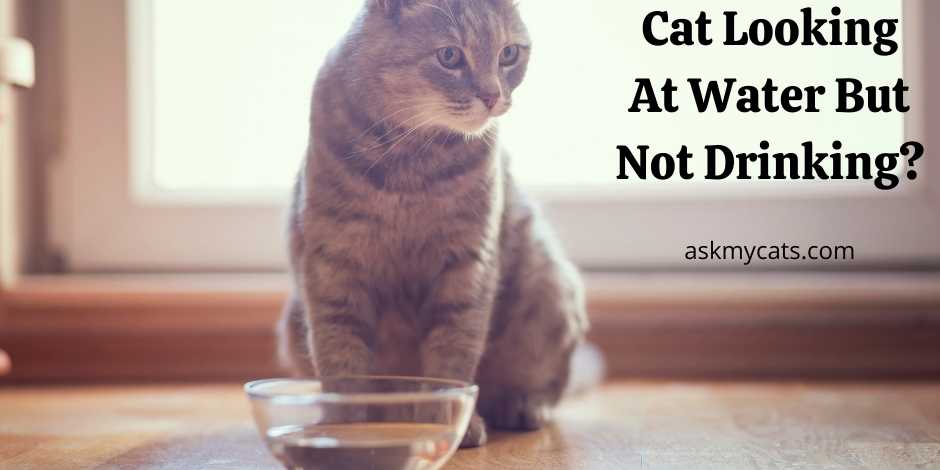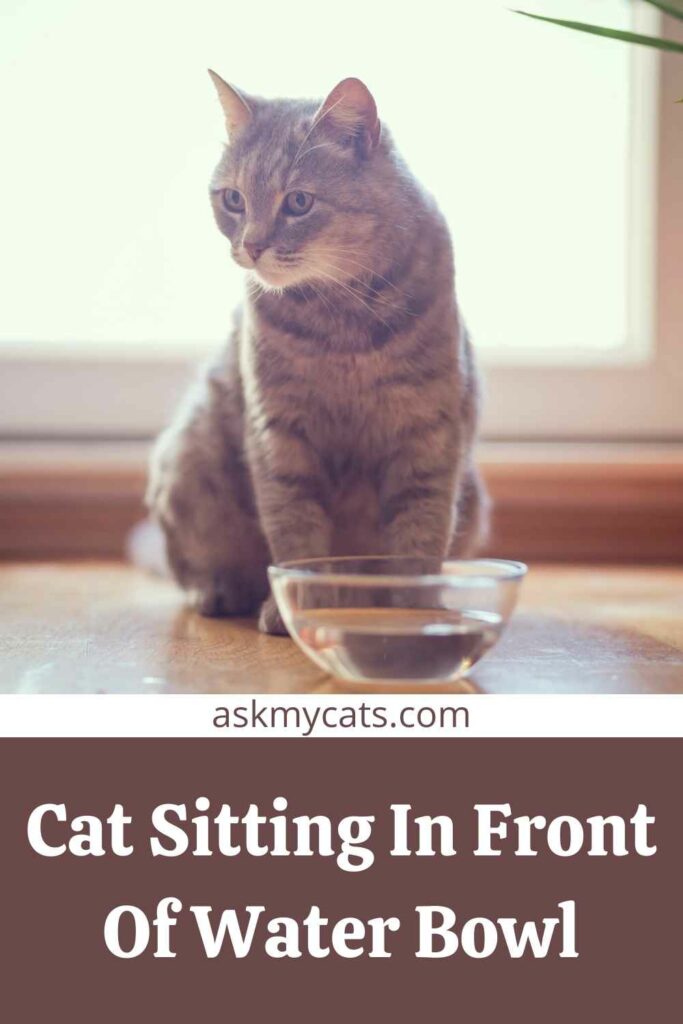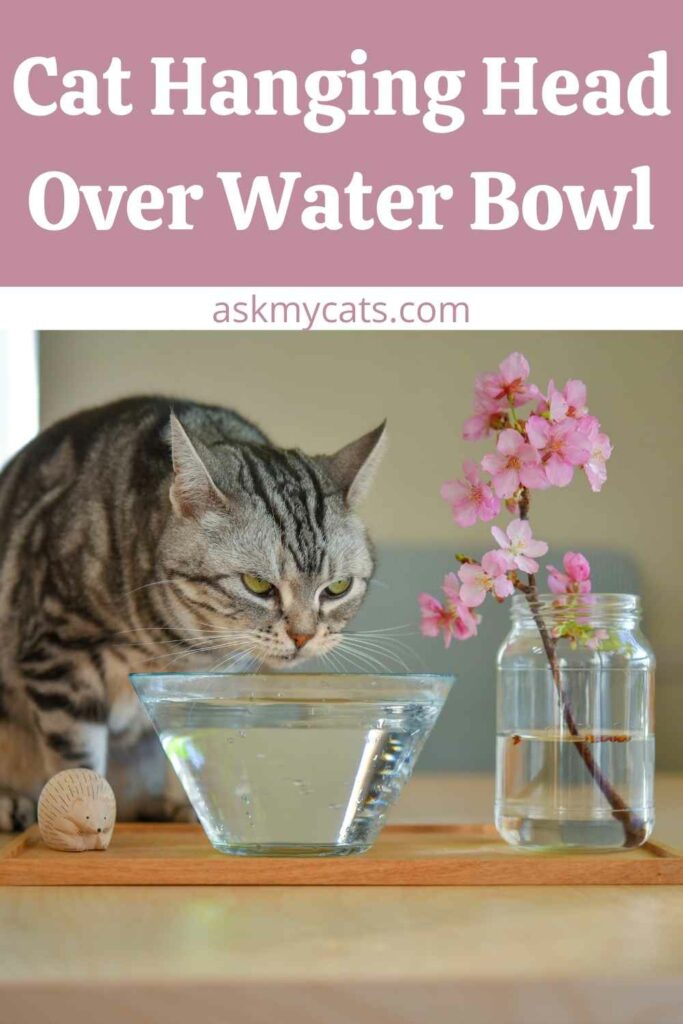Water is necessary for survival. Humans would perish in a matter of days without it. The same is true for your kitty companion; cats require water to be hydrated. If your cat becomes dehydrated, it may die as a result of the health difficulties that come with it.
If your cat looks at the water bowl but just doesn’t drink, then something is wrong with the atmosphere, the water’s portrayal, or your cat’s health.
The reasons why your cat is avoiding the water bowl are discussed in this article.


Give Your Cat the Perfect Day
Get the Free Ebook!
Why Do Cats Lay Next To Water Bowls?
Cats lay next to water bowls because it can be a natural habit, or she could do it because she is always thirsty, she is unwell, or, even worse, if she does it for hours on end and on a daily basis, it could be an indication of diabetes or renal disease.

Senior cats are more likely to engage in this activity. They may lie near their water dish, or even hang or loll their head over it since they are extremely thirsty and maybe sick.
Cats enjoy lounging, sitting, or lying down in certain locations of your home, and if she does so next to her water dish, it may simply be a natural habit. It’s a different story if she does it for several hours or perhaps the majority of the day on a daily basis. Even more so if she appears sluggish and uninterested in playing as she formerly was.
Your cat will most likely refuse to drink water, regardless of how thirsty they are. There might be a number of causes for this conduct, all of which require prompt attention in order to be resolved.
If your cat does not drink, it may succumb to dehydration and die within a few days. Your cat’s first worry is his or her health, and this is the most common reason why cats quit drinking water.
Blood loss, vomiting, renal problems, diabetes, and heatstroke are all conditions that might cause your cat to stop drinking. Thyroid problems might also make it difficult for your cat to drink water.
These serious underlying health conditions need quick attention from your veterinarian in order to restore your cat’s hydration levels and return them to health. Your cat may, however, cease drinking water for reasons unrelated to his or her health.
These characteristics are simple to solve, but you must first know what you’re searching for before making changes to your cat’s living quarters. If your cat appears to be in good health, look into the following possible causes.
Cat owners frequently remark that this strange behavior is influenced by the position of the water bowl. Your cat undoubtedly prefers to stay near the water bowl, which you have placed in an open and breezy area of your home.
Shifting the water dish to another part of the home is a simple way to see whether this is the problem.
If your cat still wants to be around the water bowl, you’ll need to think about alternative options.
According to experts, the water bowl should be placed in a sunny and open area of the house so that the cat feels at ease around it.
Also, check out can i force my cat to drink water
Cat Sitting In Front Of Water Bowl
Your cat sits in front of the water bowl without taking a sip because he only likes running water.

Some cats prefer to drink from running water sources rather than static water sources. It’s a genetic trait passed down from their forefathers. Water is still a safe haven for predators like crocodiles. While there are no alligators in your cat’s water dish, it is an inclination that cats may struggle to overcome.
Cats are tidy creatures. Your cat will most likely refuse to eat from a dirty supper bowl, and the same is true for the water dish. Make sure your cat’s water dish is empty and clean every day. Before filling the bowl with water, make sure it’s free of soap or detergent.
Some cats are averse to drinking in particular parts of the house. If you move your cat’s dish to a different room or section of your house, see how she reacts. Cats dislike having their water bowl so close to their food.
Cats are picky when it comes to their whiskers. They despise it when their whiskers brush up against the bowl’s sides, and they will avoid eating and drinking from deep bowls where they must lean in to take a sip. Make sure your cat’s water bowl has shallow sides and is large enough for its whiskers to pass through.
Cold water is inedible to cats. They enjoy the water that isn’t too hot or too cold. If you fill your cat’s bowl with cold water, they may circle the bowl, waiting for it to warm up.
Must Read: How Long Can A Cat Go Without Water?
Cat Hanging Head Over Water Bowl
When a cat hangs her head over her water bowl, she is dehydrated to the point of extreme limit. When a cat spends hours upon hours with her head dangling over her water bowl, the most prevalent cause is renal illness or failure.

She is frequently sick to her stomach at the same time. There are a few circumstances that, in principle, may cause a cat to feel this way. Diabetes issues, for example, maybe the reason.
The most prevalent serious ailment in cats is chronic renal disease. Unfortunately, it’s also the leading cause of mortality in well-cared-for cats. The name of the ailment has changed multiple times.
The ailment was once referred to as nephritis by old-school types (which was not a good term, since it means kidney inflammation, and inflammation is not a feature of the most common forms of kidney disease).
Chronic renal failure, or CRF, became the new term. Ivory tower types have lately coined the term chronic renal disease to describe the condition (CKD). Cats are prone to chronic renal disease. Anyone who has owned a cat for a long time will be familiar with it.
Young, healthy feline kidneys are capable of excreting massive amounts of waste materials into extremely little amounts of urine. This is one of the reasons why cat urine stinks so strongly on the carpet: it’s potent.
However, when the kidneys deteriorate, they lose their ability to generate such powerful pee, resulting in weaker urine. To compensate, cats begin to generate more pee. They become thirsty as a result of this.
As a result, increased thirst and urine production are often the first signs of renal illness. This symptom might be modest since chronic kidney disease develops slowly, and many owners are unaware of it.
The cat is thirsty in the early stages of renal illness but otherwise appears to be in good health. However, there is an issue with CKD: It is forward-thinking. The pace of progression varies greatly across people, but chronic kidney disease worsens over time.
Why Does My Cat Stare At Water?
Your cat stares at the water because he finds it interesting to look into the water.
If you keep your cat’s water bowl on a shelf, it’s possible that they’ll just appreciate the snug place. If you put them in a cool area, they may end up staying around their water dish to cool off. Alternatively, you might keep the water in the hottest of rooms, near a radiator, and your kitty will sit there to warm up.
It’s simple to verify that notion by simply shifting the water bowl to a different location, preferably one they don’t frequent. If your cat remains riveted to the water bowl, the placement has no bearing on his or her behavior.
Cats may be protective when it comes to their territory, which is why unneutered and unspayed cats often mark particular regions with urine and smell. Even if your cats are sterile, they might still be competitive with one another if you have more than one.
Your cat may be attempting to indicate who has control of the water supply by sitting near a water bowl.
If this is the case, simply make sure there are many water bowls strewn throughout the home to assist lessen competition.
Cat Stares At Water But Won’t Drink
Your cat stares at the water but won’t drink because he has grown old.
Our cats’ demands and behaviors change as they get older, and they can acquire diabetes, CKD, and hyperthyroidism, all of which induce severe thirst, as previously discussed.
Cats’ cognitive abilities might deteriorate as they become older. “FCD affects more than 55 percent of cats aged 11 to 15 years and more than 80 percent of cats aged 16 to 20 years,” according to the ASPCA.
During this time, your cat may exhibit behavioral changes such as forgetting how to correctly use the litterbox, restlessness, and a lack of appetite. Because they prowl around aimlessly, your cat may wind up returning back to the water bowl again and over.
They may even wind up sitting next to their water and food bowls because they are too weary to move or just have no interest in exploring the home like they used to.
Cat Hovering Over Water Bowl But Not Drinking
Your cat is hovering over the water bowl but not drinking because he is suffering from some illness.
A cat can get dehydrated if she doesn’t drink enough water or urinates more than she eats, or if she vomits or loses blood in extreme cases. Dehydration has been linked to kidney disease, heat stroke, and diabetes.
Why Is My Cat Hovering Over Water Bowl?
If your cat is hovering over the water bowl and you notice that the water bowl is not emptying at all, then you should be concerned because disinterest in thirst is caused by disorders such as diabetes, kidney failure, and adrenal gland ailments.
The degree of freshness of the water, the size and form of the bowl, and its location are all possible causes for the behavior. Additionally, your cat may have learned that turning his water bowl upside down earns him your whole, undivided attention, or he may have discovered that the water bowl is a great toy!
What Does It Mean When A Cat Doesn’t Want To Drink Water?
Your cat may just refuse to drink water because they have a preference for the type of water available to them.
Some cats prefer mineral-enriched water, while others are OK with ordinary water. Even the sort of dish your cat uses might have an impact on how much water he consumes.
Cats do not require as much water as you would believe. Their bodies require significantly less water than those of dogs or other animals, and if you give your cat canned cat food, she’s already receiving enough of it. All animals, especially obstinate cats, drink when they are thirsty.
Frequently Asked Questions
Why do cats check water?
They try to replicate rushing water by putting their paw in a water basin. Moving water appears to be fresher, making it more enticing to cats. Stagnant water has an unpleasant odor that the cats dislike.
Do cats like their water bowl next to their food bowl?
Cats are physiologically trained not to drink water that is close to their eating or toileting area; this is assumed to be an instinctual response to the risk of polluting their water with germs. Plastic bowls can pollute the water, thus cats prefer to drink from ceramic, glass, or metal bowls.
What can a cat drink besides water?
If your cat refuses to drink fresh water, try boiling some simple chicken breast or white fish and feeding the cooking liquid to them to persuade them. There should be no salt or oil in this. You might also inquire with your veterinarian about whether or not oral rehydration fluids are appropriate.
Final Words
If you observe your cat lying by a water bowl, you should be aware of what you should do. It’s conceivable that your cat enjoys hanging out around the water dish.
However, it’s possible that your cat is suffering from a serious disease. As a result, you must be vigilant and address the matter as quickly as possible.
Leave your questions in the comments section below.
